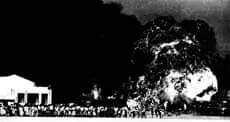The delta’s worst display: event of 8th October 1989
- Admin
- Apr 15, 2020
- 3 min read
Updated: May 9, 2020
The Mirage 2000 is one of Indian Air Force's formidable strike platform, which has distinguished itself both in terms of versatility and serviceability. In the past 35 years of it’s service with the IAF, it has proven to be a decisive weapon, be it over the icy heights of Kargil or precisely striking a terrorist camp , in a daring attack even when the visibility is near zero, the Mirage 2000 has always been a favourite of those who flew the machine, and the angel of death for those who stood against it, but everything has a catch.
Perhaps the most fatal crash of this aircraft took place on 8th October 1989, during the 55th Air Force day parade at Palam AFB in New Delhi, when a Mirage 2000H, flown by Wing Commander Ramesh Bakshi, crash landed into a wooded area near air base. There were no deaths on the ground, with only a few people sustaining minor injuries, but unfortunately the pilot was lost in the crash. The burning wreckage also set fire to two busses parked near the site.
So what happened that fateful day?
A Mirage 2000H solo display , piloted by Wing Commander Bakshi was performing at the 57th air force day parade, when the plane slammed into the ground. The aircraft crashed while performing a loop , when the pilot couldn’t recover the aircraft on time.
Prior to the failed loop, Wing Cdr. Bakshi had performed 3 loops, following which he tried to pull a fourth loop, after a few milliseconds of hesitation. Veteran pilots observing the display , felt the mistake , and judged that something was about to happen soon. The aircraft, by then under 3000ft, tried to pull up when the aircraft crashed into the wooded area nearby.
So how could this happen? The Mirage 2000, then a state of the art fighter plane, is equipped with a digital fly by wire and a Collision Aversion System (CAS), which averted the pilot in case the aircraft flew at dangerous levels or extreme angles of attack (AoA). A post crash report suggested that the pilot was pulling the stick to his might , trying to recover the aircraft. If the pilot would have had 6 more metres of altitude, he could have pulled the aircraft to safety. Luckily, the incident didn’t end up as deadly as the Ramstein airshow early that year, where 69 people were killed on ground when a MiG-29 crashed amidst spectators.
It was also revealed from investigation that by the time the aircraft crashed, it was levelled, crashing on it’s belly. This in turn, just caused the aircraft to skid on the ground reducing collateral damage. Wing Commander Bakshi was one of IAFs most experienced pilots. He also was the Officer Commanding of the 7th Squadron “Battleaxes”. Wing Cdr. Bakshi was a qualified aerobatics pilot, which by itself signifies that he was very skilled at flying. He had several display flights under his keel. He also flew at the Air Force day parade the previous year. One of his colleagues even told “The fact is, Bakshi must have had a reason why he chose to do a fourth roll when he did not have the height or the time for it. But who is to answer for him now?”. Keeping in mind further probability of crashes during display flights and avoiding damage to civilian property, the air force day parades would henceforth be located to Hindon Air Base in Ghaziabad. It was concluded that the crash happened due to pilot error, and not that of the CAS or the Fly by wire.









Comments